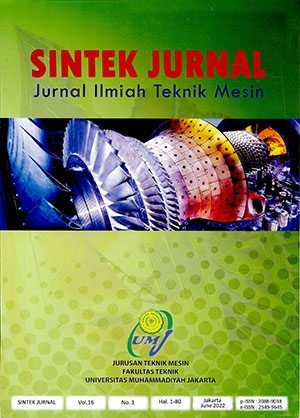PENAMBAHAN SR PADA ALUMINIUM PADUAN A356 DENGAN METODE LOST FOAM CASTING (LFC)
Main Article Content
Abstract
Article Details
- Articles published in SINTEK JURNAL are licensed under a Creative Commons Attribution-ShareAlike 4.0 International license. You are free to copy, transform, or redistribute articles for any lawful purpose in any medium, provided you give appropriate credit to the original author(s) and SINTEK JURNAL, link to the license, indicate if changes were made, and redistribute any derivative work under the same license.
- Copyright on articles is retained by the respective author(s), without restrictions. A non-exclusive license is granted to SINTEK JURNAL to publish the article and identify itself as its original publisher, along with the commercial right to include the article in a hardcopy issue for sale to libraries and individuals.
- By publishing in SINTEK JURNAL, authors grant any third party the right to use their article to the extent provided by the Creative Commons Attribution-ShareAlike 4.0 International license.
References
“Surdia, T. dan Saito, S., 1992, ‘Pengetahuan Bahan Teknik’, P.T Pradnya Paramitha, Jakarta.
Suherman, 2019, Buku Pengecoran Logam (Metode Evaporative) - Deepublish | Penerbit Buku Deepublish.
S. Tabibian, E. Charkaluk, A. Constantinescu, A. Oudin, and F. Szmytka, “Behavior, damage and fatigue life assessment of lost foam casting aluminum alloys under thermo-mechanical fatigue conditions,” Procedia Eng., vol. 2, no. 1, pp. 1145–1154, Apr. 2010.
Wang, Q.G., Apelian, D., Lados, D.A., 2001, Fatigue behavior of A356/357 aluminum cast alloys. Part II – Effect of microstructural constituents.”
X. Cao and J. Campbell, “The nucleation of Fe-Rich phases on oxide films in Al-11.5Si-0.4Mg cast alloys,” Metall. Mater. Trans. A, vol. 34, no. 7, pp. 1409–1420, Jul. 2003.
Tabibian, S., Charkaluk, E., Constantinescu, A., Szmytka, F., Oudin, A. 2013, TMF–LCF life assessment of a Lost Foam Casting A319 aluminum alloy |
Buffière, J.-Y., Savelli, S., Jouneau, P.H., Maire, E., Fougères, R, 2001. Experimental study of porosity and its relation to fatigue mechanisms of model Al-Si7-MgO.3 cast Al alloys |
M. Uludağ, R. Çetin, D. Dispinar, and M. Tiryakioğlu, “The effects of degassing, grain refinement & Sr-addition on melt quality-hot tear sensitivity relationships in cast A380 aluminum alloy,” Eng. Fail. Anal., vol. 90, pp. 90–102, Aug. 2018.
S. Suherman, A. Syakura, A. Nasution, S. Mizhar, O. Hermawan, and A. Handoko, “Influence of Additional Sr and TiB on Aluminium Al-Si-Cu-Mg Alloys for Produced Prototype Cylinder Head Motorcycle,” Proceeding Ocean Mech. Aerosp.-Sci. Eng.-, vol. 5, no. 1, pp. 79–83, 2018.
G. Timelli, D. Caliari, and J. Rakhmonov, “Influence of Process Parameters and Sr Addition on the Microstructure and Casting Defects of LPDC A356 Alloy for Engine Blocks,” J. Mater. Sci. Technol., vol. 32, no. 6, pp. 515–523, Jun. 2016.
P. Tang, W. Li, Y. Zhao, K. Wang, W. Li, and F. Zhan, “Influence of strontium and lanthanum simultaneous addition on microstructure and mechanical properties of the secondary Al-Si-Cu-Fe alloy,” J. Rare Earths, vol. 35, no. 5, pp. 485–493, May 2017.
Q. Liu et al., “Effects of Sr, Ce and P on the microstructure and mechanical properties of rapidly solidified Al 7Si alloys,” Mater. Charact., vol. 140, pp. 290–298, Jun. 2018.
İ. Öztürk, G. Hapçı Ağaoğlu, E. Erzi, D. Dispinar, and G. Orhan, “Effects of strontium addition on the microstructure and corrosion behavior of A356 aluminum alloy,” J. Alloys Compd., vol. 763, pp. 384–391, Sep. 2018.
M. Faccoli, D. Dioni, S. Cecchel, G. Cornacchia, and A. Panvini, “Optimization of heat treatment of gravity cast Sr-modified B356 aluminum alloy,” Trans. Nonferrous Met. Soc. China, vol. 27, no. 8, pp. 1698–1706, Aug. 2017.


